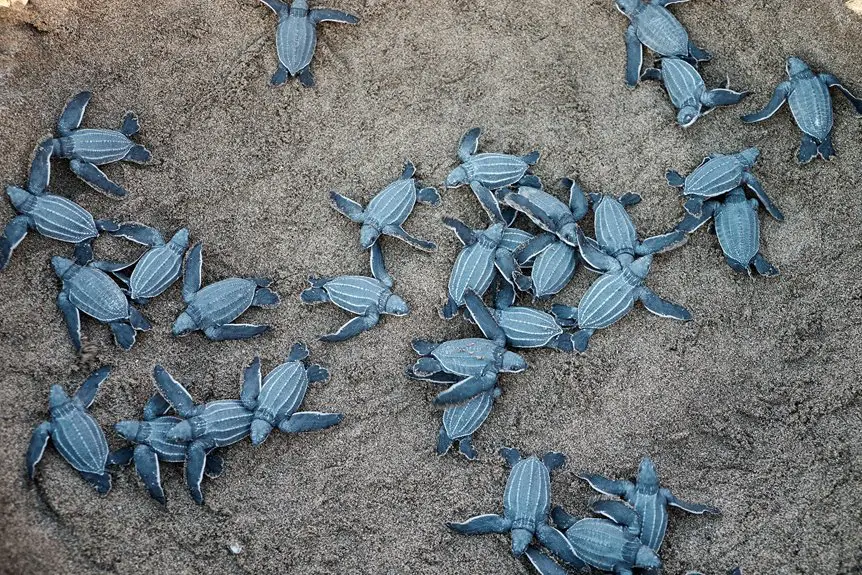Yes, a non-Gore-Tex drysuit can keep you dry if it’s made from quality waterproof materials and has well-maintained seals like latex or neoprene. These suits often use durable fabrics such as neoprene or trilaminate, which provide good protection against water intrusion. While they might be less breathable than Gore-Tex, regular maintenance guarantees reliable performance. If you want to understand how material, durability, and cost affect your experience, there’s plenty more to explore ahead.
Table of Contents
Key Takeaways
- Non-Gore-Tex drysuits can effectively keep water out using waterproof fabrics and sealed seams.
- Watertight latex or neoprene seals are essential for maintaining dryness in non-Gore-Tex suits.
- Proper maintenance, like rinsing and seal care, is critical for sustained waterproof performance.
- Non-Gore-Tex suits may have less breathability, potentially causing internal dampness during high exertion.
- Suit material quality and seal condition largely determine how dry you stay in a non-Gore-Tex drysuit.
Understanding the Basics of Drysuit Waterproofing
While you might assume all drysuits keep water out the same way, their waterproofing methods can differ considerably.
When you wear a drysuit, you rely on its ability to prevent water from entering, keeping you dry and insulated. Most drysuits achieve this by creating a sealed barrier using waterproof fabrics, taped seams, and watertight closures like latex or neoprene seals around your wrists, neck, and ankles.
Drysuits keep you dry and insulated by sealing out water with waterproof fabrics and watertight closures.
Some suits employ single-layer protection, while others add layers or coatings to enhance durability and waterproofing. Your drysuit’s performance depends on how well these elements work together to block water and withstand pressure.
Understanding these basics helps you make informed decisions about which drysuit suits your activity and environment best.
Common Materials Used in Non-Gore-Tex Drysuits
When you choose a non-Gore-Tex drysuit, you’ll often encounter materials like neoprene, trilaminate fabric, nylon, and Cordura.
Each offers unique benefits, from neoprene’s insulation to the durability of Cordura.
Understanding these materials helps you pick the right suit for your needs.
Neoprene Drysuit Advantages
Because neoprene offers excellent insulation and flexibility, many divers prefer it for non-Gore-Tex drysuits.
When you choose neoprene, you benefit from its natural buoyancy, which helps you maintain better control underwater. Its thick, foam-like structure traps heat, keeping you warm in colder waters without needing extra layers underneath.
You’ll appreciate neoprene’s stretchiness, which allows for a more comfortable fit and greater freedom of movement. Additionally, neoprene is highly durable and resistant to abrasions, making it ideal for rugged environments.
While it tends to be heavier than other materials, its thermal protection often outweighs this drawback. Overall, neoprene drysuits provide reliable warmth, flexibility, and durability, making them a solid choice if you want performance without Gore-Tex technology.
Trilaminate Fabric Features
Neoprene’s warmth and flexibility make it a popular choice, but if you’re looking for a lighter, more streamlined option, trilaminate fabrics offer a compelling alternative.
Trilaminate drysuits consist of three bonded layers: a waterproof membrane sandwiched between two outer fabrics. This construction gives you excellent water resistance without the bulk of neoprene. Typically, these layers include a tough outer nylon or polyester for durability, a middle waterproof breathable membrane, and a soft inner lining for comfort.
You’ll appreciate how trilaminate suits allow more freedom of movement and reduce overheating in warmer conditions. While they don’t provide insulation like neoprene, you can easily layer underneath to maintain warmth.
Nylon and Cordura Benefits
Although trilaminate fabrics offer great breathability and flexibility, nylon and Cordura stand out for their exceptional durability and abrasion resistance in non-Gore-Tex drysuits.
When you choose a drysuit made from these materials, you’re investing in rugged gear that withstands rough conditions, like rocky shorelines or jagged boat edges.
Nylon’s lightweight nature won’t weigh you down, while Cordura’s tightly woven fibers resist tears and punctures effectively.
Both materials also resist water absorption, keeping you dry longer.
While they may not breathe as well as trilaminate, their toughness makes them ideal for demanding environments.
Comparing Breathability: Gore-Tex vs. Alternative Fabrics
When you compare Gore-Tex to alternative fabrics, you’ll notice key differences in how they manage moisture.
Gore-Tex typically offers superior breathability, helping sweat escape more efficiently during use.
However, some alternatives can perform well depending on conditions, so understanding these variations is essential.
Moisture Management Differences
Because breathability plays a crucial role in keeping you comfortable during extended drysuit use, understanding how Gore-Tex compares to alternative fabrics is essential.
Gore-Tex excels at moisture management by allowing sweat vapor to escape while blocking water from entering. This means you stay drier inside, even during intense activity.
Alternative fabrics often rely on different membrane technologies or coatings, which may not be as efficient at moving moisture away from your skin. As a result, you might notice more internal dampness or condensation buildup with non-Gore-Tex suits.
While some alternatives offer decent moisture control, they typically don’t match Gore-Tex’s balance of waterproofing and breathability.
Knowing these differences helps you choose a drysuit that fits your activity level and comfort needs.
Fabric Performance in Use
Understanding moisture management sets the stage for examining how these fabrics perform during actual use.
When you wear a Gore-Tex drysuit, you benefit from superior breathability that helps sweat escape, keeping you comfortable and dry inside. Non-Gore-Tex alternatives often use different membranes or coatings, which mightn’t match Gore-Tex’s moisture vapor transmission rates.
Here’s what you need to evaluate:
- Gore-Tex’s microporous structure allows more efficient moisture vapor escape.
- Alternative fabrics may trap more sweat, leading to dampness and discomfort.
- In high-exertion activities, Gore-Tex typically prevents overheating better than many alternatives.
Durability and Maintenance of Non-Gore-Tex Drysuits
Although non-Gore-Tex drysuits often come with unique fabric blends, you’ll find their durability depends heavily on how you care for them. Proper maintenance extends their lifespan and keeps seals and zippers functioning well. You should rinse your suit with fresh water after each use and store it away from direct sunlight.
| Maintenance Task | Recommended Frequency |
|---|---|
| Rinse with fresh water | After every use |
| Check and lubricate zippers | Monthly |
| Inspect seals for damage | Before each use |
Performance in Different Water Conditions
Caring for your non-Gore-Tex drysuit helps maintain its performance, but how it handles different water conditions is just as important.
Proper care and understanding water conditions are key to your non-Gore-Tex drysuit’s lasting performance.
You need to understand how it reacts in various environments to trust it fully.
- Cold Water: Non-Gore-Tex suits usually insulate well, but layering underneath is essential since they may not breathe as efficiently, leading to moisture buildup inside.
- Saltwater: Salt can be harsh, so rinse your suit thoroughly after every use to prevent fabric degradation and maintain waterproof seals.
- Freshwater: Freshwater is gentler on your suit, but you should still clean and dry it properly to avoid mold and material wear.
Cost Considerations and Value for Money
When choosing a non-Gore-Tex drysuit, you’ll want to weigh initial costs against long-term value. These suits usually come with a lower price tag than Gore-Tex models, making them attractive if you’re budget-conscious. However, consider durability, maintenance, and performance to guarantee you’re not spending more over time. Non-Gore-Tex suits can offer solid waterproofing but might need more care. Here’s a simple cost-value comparison:
| Factor | Non-Gore-Tex Drysuit |
|---|---|
| Initial Cost | Lower ($300 – $700) |
| Maintenance | Moderate (regular checks) |
| Durability | Good but less than Gore-Tex |
| Repair Costs | Affordable |
| Performance Lifespan | 3-5 years with proper care |
Balance upfront savings with ongoing upkeep to find what fits your needs best.
User Experiences and Expert Recommendations
Since non-Gore-Tex drysuits come with unique trade-offs, users often share varied experiences regarding comfort, durability, and waterproofing.
Non-Gore-Tex drysuits offer varied comfort and durability, with user experiences highlighting important trade-offs.
You might find some suits less breathable but still effective at keeping water out. Experts recommend you focus on your specific needs, such as activity type and water temperature, before choosing.
To guide you, here are common points users and pros highlight:
- Comfort: Some suits feel stiffer but improve after a few uses.
- Durability: Non-Gore-Tex fabrics can resist abrasions well but vary by brand.
- Waterproofing: Proper maintenance and seals are essential to stay dry.
Frequently Asked Questions
Can Non-Gore-Tex Drysuits Be Repaired if Punctured?
You can repair non-Gore-Tex drysuits if punctured by patching small holes with repair kits. For bigger damage, professional services help restore waterproof seals, so you won’t have to replace your suit immediately.
How Do Non-Gore-Tex Drysuits Handle Extreme Cold?
Non-Gore-Tex drysuits handle extreme cold by relying on your layering system beneath. They don’t offer as much breathability, so you’ll want high-quality insulation layers to stay warm and avoid moisture buildup during long, cold dives.
Are Non-Gore-Tex Drysuits Suitable for Scuba Diving?
You can use non-Gore-Tex drysuits for scuba diving, but they might not offer the same breathability or durability. They’ll keep you dry, but expect less comfort during long or cold dives compared to Gore-Tex suits.
What Types of Seals Are Used in Non-Gore-Tex Drysuits?
You’ll find non-Gore-Tex drysuits use latex or neoprene seals at wrists and neck to keep water out. These materials flex and fit snugly, ensuring you stay dry and comfortable during your dives or water activities.
Do Non-Gore-Tex Drysuits Require Special Undergarments?
Yes, you’ll want special thermal undergarments with non-Gore-Tex drysuits to stay warm and comfortable. These layers wick moisture and provide insulation since the drysuit itself isn’t breathable like Gore-Tex options.
- What Is Camel Hair Fabric Called? (Exploring Names Like Aba) - July 3, 2025
- Solving the “Goat or Camel Hair Fabric” Crossword Puzzle Clue - July 3, 2025
- Camel Hair Fabric Crossword Clue: The Definitive Answer - July 3, 2025







